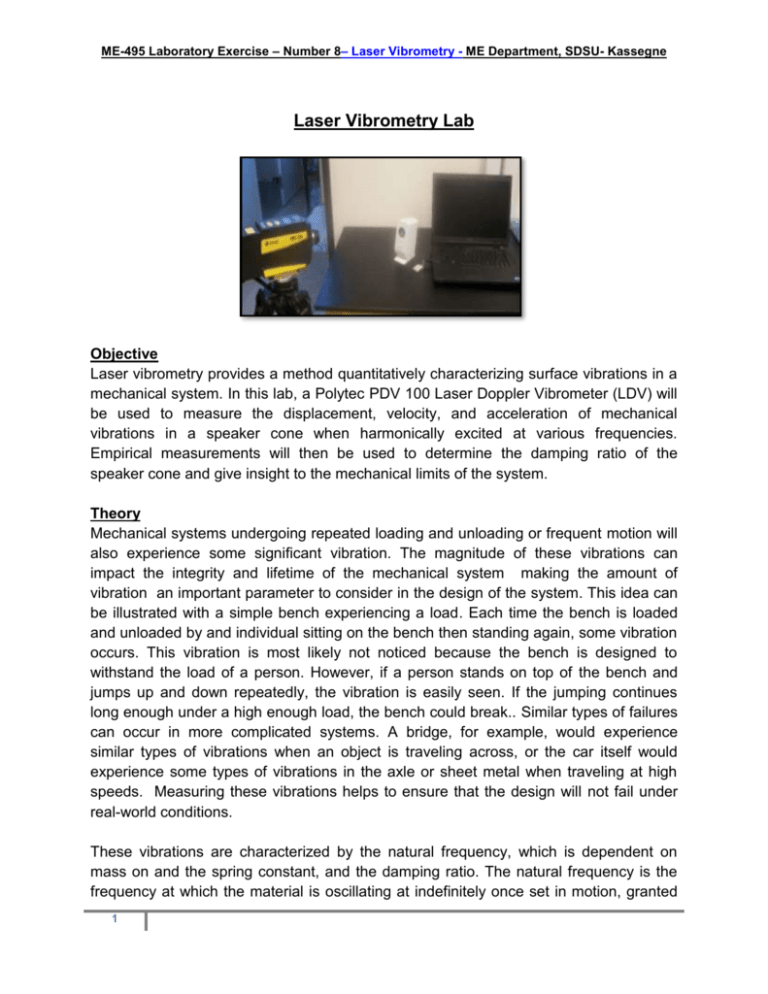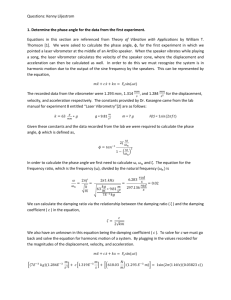
ME-495 Laboratory Exercise – Number 8– Laser Vibrometry - ME Department, SDSU- Kassegne
Laser Vibrometry Lab
Objective
Laser vibrometry provides a method quantitatively characterizing surface vibrations in a
mechanical system. In this lab, a Polytec PDV 100 Laser Doppler Vibrometer (LDV) will
be used to measure the displacement, velocity, and acceleration of mechanical
vibrations in a speaker cone when harmonically excited at various frequencies.
Empirical measurements will then be used to determine the damping ratio of the
speaker cone and give insight to the mechanical limits of the system.
Theory
Mechanical systems undergoing repeated loading and unloading or frequent motion will
also experience some significant vibration. The magnitude of these vibrations can
impact the integrity and lifetime of the mechanical system making the amount of
vibration an important parameter to consider in the design of the system. This idea can
be illustrated with a simple bench experiencing a load. Each time the bench is loaded
and unloaded by and individual sitting on the bench then standing again, some vibration
occurs. This vibration is most likely not noticed because the bench is designed to
withstand the load of a person. However, if a person stands on top of the bench and
jumps up and down repeatedly, the vibration is easily seen. If the jumping continues
long enough under a high enough load, the bench could break.. Similar types of failures
can occur in more complicated systems. A bridge, for example, would experience
similar types of vibrations when an object is traveling across, or the car itself would
experience some types of vibrations in the axle or sheet metal when traveling at high
speeds. Measuring these vibrations helps to ensure that the design will not fail under
real-world conditions.
These vibrations are characterized by the natural frequency, which is dependent on
mass on and the spring constant, and the damping ratio. The natural frequency is the
frequency at which the material is oscillating at indefinitely once set in motion, granted
1
ME-495 Laboratory Exercise – Number 8– Laser Vibrometry - ME Department, SDSU- Kassegne
that there is no damping. However, if damping is put into the system, the oscillations
will eventually die out, and the materials will experience less vibration over time.
Therefore, by considering the natural frequency of materials, the system can be
designed to increase damping, which will decrease strain on the materials and thus
decrease the likelihood of failure.
The Laser Doppler Vibrometer allows for the measurement of vibrations by projecting a
laser at the surface of interest. When the surface vibrates, the velocity of the vibration is
calculated by the software using the relationship illustrated by the Doppler Effect. From
the velocity, other data can be obtained such as the displacement and acceleration.
In this lab, displacement, velocity, and acceleration of the vibrations of a speaker cone
will be measured in response to a harmonic input. In this system, the speaker cone has
a mass that gives it an inertial force contribution, an elastic stiffness that contributes to
the spring force, and some damping forces. When all these forces are present, the
system can be described as second order system by the following equation:
m
d 2s
ds
c ks F (t )
2
dt
dt
(1)
Where S is the displacement, m is the mass, c is the damping coefficient, and k is the
spring constant. F(t) the input force that excites the system, can be harmonic or a step
input.
The damping coefficient is related to the damping ratio by the equation:
c
2 km
(2)
For a second order system with a step input, the underdamped (ζ<1)solution to equation
(1) is:
2
ME-495 Laboratory Exercise – Number 8– Laser Vibrometry - ME Department, SDSU- Kassegne
(3)
Where ωnd is the natural frequency.
The overdamped (ζ>1)solution to the equation would be:
(4)
The image below shows an example of overdamped, underdamped, and critically
damped responses of a second order system to a step input.
Figure 1: Second Order System Response to a step input
For a harmonically excited system:
F(t)=Fosin(Ωt) (4)
And thus, the solution to equation (1) becomes
(5)
This solution gives the normalized amplitude where sd is the amplitude of the periodic
steady state displacement and
3
ME-495 Laboratory Exercise – Number 8– Laser Vibrometry - ME Department, SDSU- Kassegne
(6)
One method to estimate the damping is to harmonically excite the system through a
series of frequencies, plot the amplitude ratio vs frequency ratio to obtain a curve like
the one shown in figure 1. A precise determination of damping ratio can be obtained by
also measuring the amplitude of the velocity, acceleration, and displacement at one
frequency and using equations 1 and 2 to calculate the damping ratio.
Figure 2: Theoretical damping curves [1].
Equipment
● PDV 100 Portable Digital Vibrometer Sensor
● BNC Cable
● USB Polytec Hardlock
● PDV 100 Portable Digital Vibrometer Power supply
● ArtDio Portable Computer Speaker
● USB Cable
● Polytec VIB – E – 220 Data Acquisition System
● Tripod
● Laptop Computer
4
ME-495 Laboratory Exercise – Number 8– Laser Vibrometry - ME Department, SDSU- Kassegne
Procedure
System Set-Up
1. Assemble the PDV 100 Portable Digital Vibrometer Sensor on top of a tripod
2. Connect BNC cable to “Analog Out” connection on the PDV 100 Portable Digital
Vibrometer Sensor
3. Connect the other end of BNC cable to “Velo” on Polytec VIB – E – 220 Data
Acquisition System
4. Connect Polytec VIB – E – 220 Data Acquisition System to a laptop using USB
cable
5. Plug portable speakers to the headphone jack on the laptop
6. Plug the PDV 100 Portable Digital Vibrometer Power supply to an outlet and the
other end; plug it into PDV 100 Portable Digital Vibrometer Sensor that reads “12V,
max. 15W.”
7. Plug the USB Polytec Hardlock to one of the USB ports of the computer.
8. Open the Laser lens cover. (Caution: Laser light is damaging to eyes. Do not look
into the Laser light and make sure you close the lens cover when the Laser is not in
use.)
9. Focus the Laser light on the speaker cone.
Experiment 1:Harmonic Input into Speaker Cone (Ω=2π*1kHz)
In experiment 1, you will find the amplitude of the frequency response of the speaker
cone to an input F(t)=1sin(Ωt) where Ω=2*π*1kHz. Record the frequency response
amplitude at 1 kHz for displacement, velocity, acceleration, and export the graph.
Displacement at 1 kHz
1.
2.
3.
4.
5.
6.
7.
8.
Open VibrSoft Software
Analyzer Domain FFT
Analyzer Display Type Magnitude
Analyzer Cursor
Click on the graph and move the vertical line at the Frequency (kHz) of 1.
Analyzer SignalDisplacement
Acquisition Continuous (F8)
Acquisition Setting
a. A menu should pop up now. Click the “Channel” tab.
i. On the vibrometer channel
1. Active: Check marks the box.
2. Direction: +Y
3. Coupling: DC
4. ICP: Check marks the box.
5. Quantity: Displacement
6. Click Ok.
b. Click on the ‘General’ tab and ensure that “peak” is selected
5
ME-495 Laboratory Exercise – Number 8– Laser Vibrometry - ME Department, SDSU- Kassegne
9. Open Audacity
a. A menu would pop up now. Under the drop down menu for the waveform,
choose “Sine.”
b. Frequency/Hz setting: 1000
c. Amplitude: 1
d. Length (seconds): 30 (Set length longer if necessary.)
e. Click “Generate Tone.
f. Click the “Play Button.”
10. Let it run for least 5 seconds. Then click “Acquisition” Stop (F10)
11. Stop the sound in the Audacity.
12. Record the magnitude.
13. File Save Graphic
14. Naming file:
a. Group_letter_displacement_1kHz_FrequencyDomain
15. Export ASCII and save with a descriptive file name.
16. In Excel, pull up the saved file.
17. In VibrSoft Click AnalyzerDomaintime
18. Repeat Steps 13-16 excet name file as:
a. Group_letter_displacement_1kHz_TimeDomain
19.
Acceleration at 1 kHz
Repeat Step 1 – 5 from the 'displacement' experiment above.
Analyzer SignalAcceleration
Repeat Step 7 like the above for the displacement at 1 kHz.
Acquisition Setting
a. A menu should pop up now. Click the “Channel” tab.
i. On the vibrometer channel
1. Active: Check marks the box.
2. Direction: +Y
3. Coupling: DC
4. ICP: Check marks the box.
5. Quantity: Acceleration
6. Click Ok.
5. Repeat Step 9 – 18 like the above for the acceleration at 1 kHz.
6. Naming file:
a. Group_letter_acceleration_1kHz_FrequencyDomain/TimeDomain
1.
2.
3.
4.
Velocity at 1 kHz
1.
2.
3.
4.
Repeat Step 1 – 5 from the 'displacement' experiment above.
Analyzer SignalVelocity
Repeat Step 7 like the above for the displacement at 1 kHz.
Acquisition Setting
a. A menu should pop up now. Click the “Channel” tab.
6
ME-495 Laboratory Exercise – Number 8– Laser Vibrometry - ME Department, SDSU- Kassegne
i. On the vibrometer channel
1. Active: Check marks the box.
2. Direction: +Y
3. Coupling: DC
4. ICP: Check marks the box.
5. Quantity: Velocity
6. Click Ok.
5. Repeat Step 9 – 18 like the above for the acceleration at 1 kHz.
6. Naming file:
a. Group_letter_acceleration_1kHz_FrequencyDomain/TimeDomain
Experiment 2
In experiment 2, investigate the frequency contents of two sound sources in the
frequency domain and make some qualitative observation about what frequency ranges
are correlated with the melody and bass.
Repeat Steps 1 – 4, 6, and 7 in the experiment 1 for the displacement.
Pick a Classical music piece from YouTube and play it for about 25 seconds.
Save the file using Export command.
Pick a music rich in beats (Electronic music piece from YouTube and play it for
about 25 seconds.
5. Save the file using Export command.
6. Plot both files from steps 3 & 5 together.
1.
2.
3.
4.
Data Reduction:
Constants: assume k=63g/mm*g, g=9.81m/s^2 and m=7g
Given that n k / m , use data gathered in experiments 1 and 2 and equations 1, 2, 5
and 6 to calculate ζ, the damping ratio. Use the time domain graph to ensure that your t
in equation 1 is correlated to the peak amplitude (acquisition settings ensure that the
magnitude shown in the frequency domain is at peak amplitudes).
Questions:
1. Determine the phase angle for the data from the first experiment.
2. Find c when the system is critically damped.
3. What can you say about the frequency contents of the two music pieces in
Experiment 2?
4. How is 'beat' of music related to frequency?
7
ME-495 Laboratory Exercise – Number 8– Laser Vibrometry - ME Department, SDSU- Kassegne
References
[1] Beckwith, T. G., Roy D. Marangoni, and John H. Lienhard. Mechanical
Measurements. Upper Saddle River, NJ: Pearson/Prentice Hall, 2007. Print.
8








